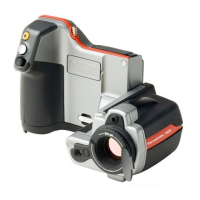■ The viewing angle is nearly perpendicular to the surface being imaged. Interfering
sources of infrared radiation such as lights, heat emitters, electric conductors, re-
flective elements are minimised.
The method of analysis will depend somewhat on analysis software used, but the key
stages are as follows:
Produce an image of each anomaly or cluster of anomalies.
■ Use a software analysis tool to enclose the anomalous area within the image, taking
care not to include construction details that are to be excluded.
■ Calculate the area below the threshold temperature for internal surveys or above
the threshold temperature for external surveys. This is the defect area. Some
anomalies that appeared to be defects at the time of the survey may not show defect
areas at this stage.
■ Add the defect areas from all the images ∑A
d
.
■ Calculate the total area of exposed building fabric. This is the surface area of all
the walls and roof. It is conventional to use the external surface area. For a simple
shape building this is calculated from overall width, length and height.
A
t
= (2h(L + w)) + (Lw)
■ Identify the critical defect area A
c
. Provisionally this is set at one thousandth or
0.1% of the total surface area.
A
c
= A
t
/1000
■ If ∑A
d
< A
c
the building as a whole can be considered to have ‘reasonably contin-
uous’ insulation.
27.3.8.7 Reporting
Reports should certificate a pass/fail result, comply with customers requirements and
as a minimum include the information required by BSEN 13187. The following data
is normally required so that survey can be repeated following remedial action.
■ Background to the objective and principles of the test.
■ Location, orientation, date and time of survey.
■ A unique identifying reference.
■ Thermographer’s name and qualifications.
■ Type of construction.
■ Weather conditions, wind speed and direction, last precipitation, sunshine, degree
of cloud cover.
■ Ambient temperatures inside and outside before, at the beginning of survey and
the time of each image. Air temperature and radiant temperature should be
recorded.
■ Statement of any deviation from relevant test requirements.
■ Equipment used, last calibration date, any knows defects.
■ Name, affiliation and qualifications of tester.
Publ. No. 1558792 Rev. a460 – ENGLISH (EN) – July 1, 2010 175
27 – Introduction to building thermography

